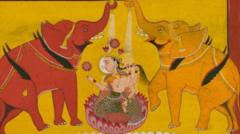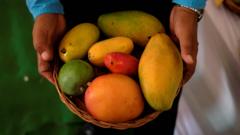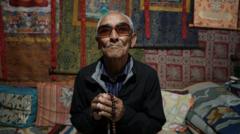'Ancient India: Living Traditions', a new exhibition at the British Museum, features a remarkable collection of 189 artistic pieces reflecting the spiritual evolution of Hinduism, Buddhism, and Jainism. The display explores the transformation of religious iconography and illustrates how ancient traditions continue to resonate with modern faith practices.
Unveiling Spiritual Treasures: India's Artistic Legacy at the British Museum

Unveiling Spiritual Treasures: India's Artistic Legacy at the British Museum
The British Museum's exhibition 'Ancient India: Living Traditions' highlights the evolution of spiritual art from India, showcasing 189 artifacts that tell the story of three major religions.
A new exhibition at the British Museum in London, titled 'Ancient India: Living Traditions', presents an extensive collection of 189 significant artifacts, tracing the rich journey of India's spiritual art. The exhibition offers visitors a unique opportunity to explore art forms that include sculptures and paintings dating back over 2,000 years, along with narrative panels and manuscripts that shed light on the evolution of spiritual expression in India.
Between 200 BC and AD 600, India's artistic narrative underwent a dramatic change, as representations of gods, goddesses, and enlightened figures transitioned from symbolic depictions to more human forms. The three ancient religions of Hinduism, Buddhism, and Jainism, while sharing cultural origins rooted in the worship of nature spirits like serpents and peafowl, experienced significant shifts in iconography during this transformative era. "The humanization of divine figures is a fascinating transition that remains relevant today," remarks Sushma Jansari, the exhibition's curator.
The exhibition is divided into five sections, commencing with an exploration of nature spirits, followed by separate subsections for each of the three religions, and culminating with the dissemination of these faiths and their artistic expressions beyond India's borders to regions such as Cambodia and China. Notably, the Buddhist section features a striking two-sided sandstone panel illustrating the evolution of the Buddha's representation—from an earlier symbolic portrayal of a tree and throne to an intricate human form from around AD 250.
In the Hindu section, an early bronze statue epitomizes the evolution of sacred imagery by depicting goddesses with complex attributes, showcasing the characteristics that would shape representations of female deities in later centuries. Jain art, on the other hand, focuses on the 24 enlightened teachers, or tirthankaras, with early examples dating back approximately 2,000 years, identified by a sacred symbol on their chests.
This exhibition is distinct as it is the first to collectively examine the origins of these three art traditions, carefully tracing the provenance of each object displayed and emphasizing the diverse cultural narratives behind them. Notably, it has been observed that many donors of Buddhist art were women. However, questions remain regarding the reasons behind the artistic transformation during this time—issues that continue to provoke scholarly debate.
The exhibition also aims to provide visitors with a multi-sensory experience, incorporating scents, sounds, and vibrant colors to evoke the atmosphere of contemporary religious shrines. Complementing the artifacts are films showcasing practicing worshippers from each faith in Britain, reinforcing the notion that this exhibition highlights living traditions relevant to millions worldwide, far beyond modern India's boundaries.
'Ancient India: Living Traditions' is on display at the British Museum, London, from May 22 to October 19.






















